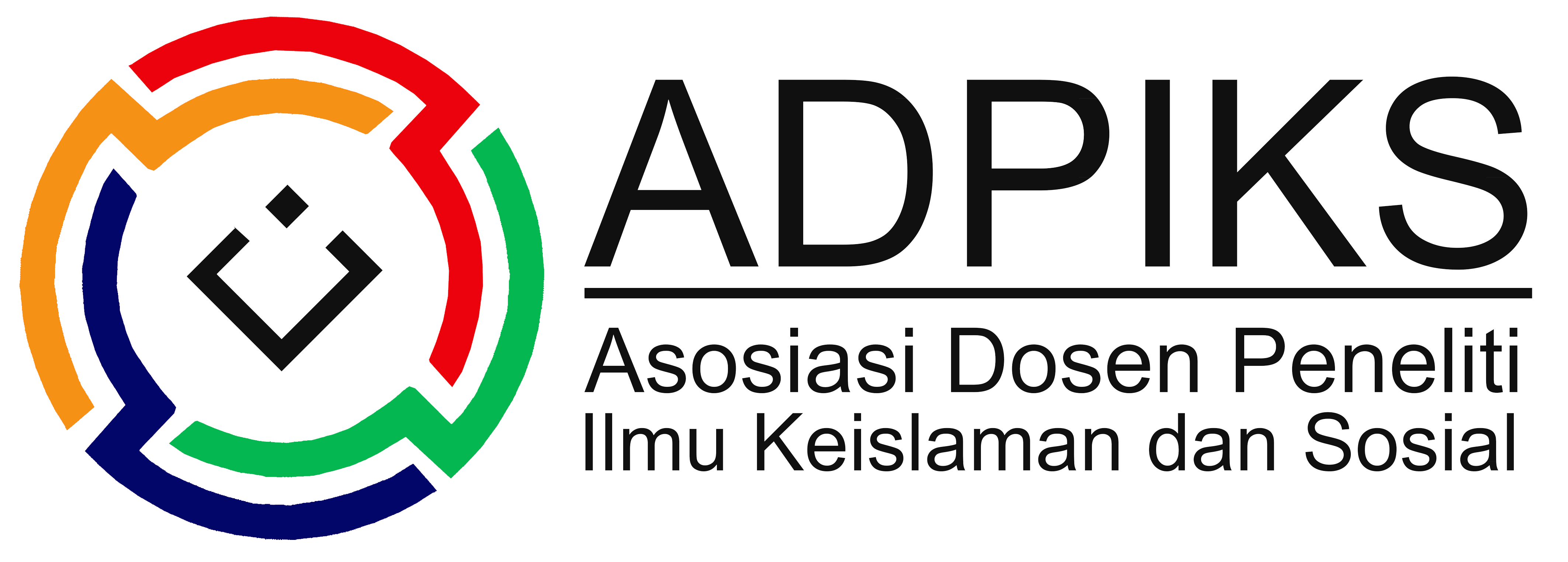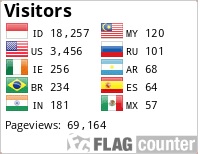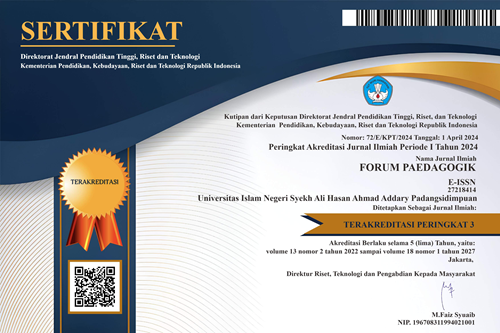chrome_reader_mode Online Submissions
Registration and login are required to submit items online and to check the status of current submissions.
Already have a Username/Password for FORUM PAEDAGOGIK?
Go to Login
class Author Guidelines
Carefully read the Author Guidelines as follows:
A. General Requirements
- Manuscripts submitted to Forum Paedagogik Jurnal Pendidikan Agama Islam should be research-based papers that have not been published or are under consideration elsewhere.
- Manuscripts must be in English or Indonesia. It should be typed in MS Word doc. format; using 11-pt Time New Roman font; left, top margins are 3 cm, and right, bottom margins are 3 cm; Spacing Exactly 18 pt with paper size A4; 13-18 pages in length or 6000-9000 words.
- The manuscript will be reviewed by subject reviewers, while the editors reserve the right to edit the manuscript for format consistency without altering the substance.
- Make sure that the manuscript is prepared using the Article Template. Use the Online Submission Guidelines for access to the Open Journal Systems (OJS).
- The manuscript must be submitted through the OJS (Forum Paedagogik Jurnal Pendidikan Agama Islam). For confirmation, the Submission Checklist and Statement of Originality must be emailed to the Journal Editor (paedagogikftikiain@gmail.com)
- The citations and references should follow the style of the American Psychological Association (APA) 7th Edition and use Reference Management Software ZOTERO (http://www.zotero.org) or MENDELEY (www.mendeley.com).
- The manuscript must be checked in terms of grammar, structure, spelling, etc. It is suggested to use Grammar Checker Software GRAMMARLY (http://app.grammarly.com).
B. Manuscript Structure
- The article structure contains (a) Title; (b) Author(s) Name, (c) Affiliation, (d) Email Address; (e) English Abstract and Indonesian Abstract; (f) Keywords; (g) INTRODUCTION (WITHOUT heading); (h) RESEARCH METHOD; (i) RESEARCH FINDINGS AND DISCUSSION; (j) CONCLUSION (and Suggestion); (k) Acknowledgements (if necessary); and (l) REFERENCES.
- Title: the title of the article should be written in a simple form, concise, and informative in a phrase or clause format (Capitals-lowercase, Bold, Center, Time New Roman font 12, max 14 words)
- Author(s) Name: The full name of the author(s) must be written without academic title(s) in 12-pt Time New Roman font.
- Affiliation: The affiliation (Full name University, and country) should be written below the name in 11-pt Time New Roman font.
- Email Address; The email address of the Corresponding Author should be written below the affiliation in 10-pt Time New Roman font. (Corresponding Author will handle correspondence at all stages of refereeing and publication, also post-publication; this responsibility includes answering any future queries about the Methodology and Materials of the paper). Ensure that the e-mail address is given and that contact details are kept up to date by the Corresponding Author.
- English/Arabic Abstract and Indonesian Abstract: An abstract must go with each manuscript; it should be clear, descriptive, and provide a brief overview of the problem studied. It is also with no figure, table, equation, or citation), between 150 – 250 words and written as a single paragraph in English in Time New Roman font 11 single space. The abstract should include the purposes of the research, methodology, and findings. The abstract should be ended with a comment about the importance of the results or a conclusion brief.
- INTRODUCTION: This section is to introduce your paper including the background of the study, issues to be solved, and reviews of related findings which consist of 700 – 1000 words (1.5 – 2.5 pages) with the font Time New Roman font 12 point Line Spacing 1,5 pt with paper size A4, should be written without heading. The introduction should include key references to appropriate work. It states the significant contribution of the research. The introduction should consist of the background of the study, research contexts, literary review, and research objective (at the end of the introduction). The introduction should explicitly state the research gap and show the scientific merit or novelty of the research. All introductions should be presented in the form of paragraphs, not pointers.
- RESEARCH METHOD: This sub-title must consist of a brief description of the methods of the research; including research design, sources of the research (population/sample/ participants of the research, instrument used, techniques of collecting the data, and data analysis) without subtitle, which consist of 1 – 2 paragraphs (150 – 300 words or 0.5 – 1 page). It is written in the font Time New Roman font 12 with Line Spacing of 1,5 pt.
- RESEARCH FINDINGS AND DISCUSSION: This section will describe the findings of the research, then complete with a discussion. It must consist of elaborated between 1500 – 4500 words (8 – 10 pages). Research Findings is the explanation of the result of the research based on analysis of the data whether it is in qualitative or quantitative approaches. The findings section consists of a description of the results of the data analysis to answer the research question(s). The findings should summarize (scientific) findings rather than provide data in great detail. Please highlight the differences between your results or findings and the previous publications by other researchers. This section should be explained in several subsections with a detailed explanation of the findings. The First Sub Topic (Finding 1): The author(s) should make a sub-topic in bold type and capitalize each word. The findings are the description of the result, and it can be completed with chart(s), graphic(s), diagram(s), or table (s); The Second Sub Topic (Finding 2): The findings should summarize (scientific) findings rather than providing data in great detail. Please highlight the differences between your results or findings and the previous publications by other researchers. This section should be explained in several subsections with a detailed explanation of the findings; The Third Sub Topic (Discussion): This sub-topic describes the relationship of your findings to theory and other research findings. It is not for repeating the research findings or the theory, but to elaborate on the result. The author(s) must show the novelty of this study compared to the others.
- CONCLUSION: This section is in the format of a paragraph that consists of 1 – 2 paragraphs (300 – 500 words or 0.5 – 1 page only). It should indicate the findings clearly. It also explains the advantages and disadvantages of your findings, and the possibility to develop the research.
- Acknowledgment: If it is needed, you must say in this sub-discussed about the involvement of other parties or institutions or other institutions in the research conducted, just written in 2 – 5 sentences only.
- REFERENCES: Every source cited in the body of the article should appear in the References, and all sources appearing in the References should be cited in the body of the article. The references should be more up-to-date (published in the last 5-10 years). The primary sources cited in your paper are in the forms of journal articles, proceedings, and research reports including theses and dissertations that can be accessed online (show the DOI address/URL). Citations from online journal articles should be at least 80% of the total references cited. The References should be presented alphabetically and chronologically and be set to 12-pt Time New Roman font, justified, with single line spacing and hanging indent. Check each reference against the original source (author name, volume, issue, year, DOI number). Please use the Reference Manager Application (ZOTERO/ MENDELEY) to manage the references for your paper. Use other published articles in the same journal as models.
Subheading System:
- LEVEL ONE: ALL CAPITAL, BOLD, LEFT JUSTIFICATION
- Level Two: Capitals-lowercase, Bold, Left Justification
- Level three: Capitals-lowercase, italics-bold, left justification
message Submission Preparation Checklist
As part of the submission process, authors are required to check off their submission's compliance with all of the following items, and submissions may be returned to authors that do not adhere to these guidelines.
- The submission has not been previously published, nor is it before another journal for consideration (or an explanation has been provided in Comments to the Editor).
- The submission file is in OpenOffice, Microsoft Word, RTF, or WordPerfect document file format.
- Where available, URLs for the references have been provided.
- The text is single-spaced; uses a 12-point font; employs italics, rather than underlining (except with URL addresses); and all illustrations, figures, and tables are placed within the text at the appropriate points, rather than at the end.
- The text adheres to the stylistic and bibliographic requirements outlined in the Author Guidelines, which is found in About the Journal.
- If submitting to a peer-reviewed section of the journal, the instructions in Ensuring a Blind Review have been followed.
assignment Copyright Notice
https://creativecommons.org/licenses/by-sa/4.0
assignment Privacy Statement
The names and email addresses entered in this journal site will be used exclusively for the stated purposes of this journal and will not be made available for any other purpose or to any other party.
















